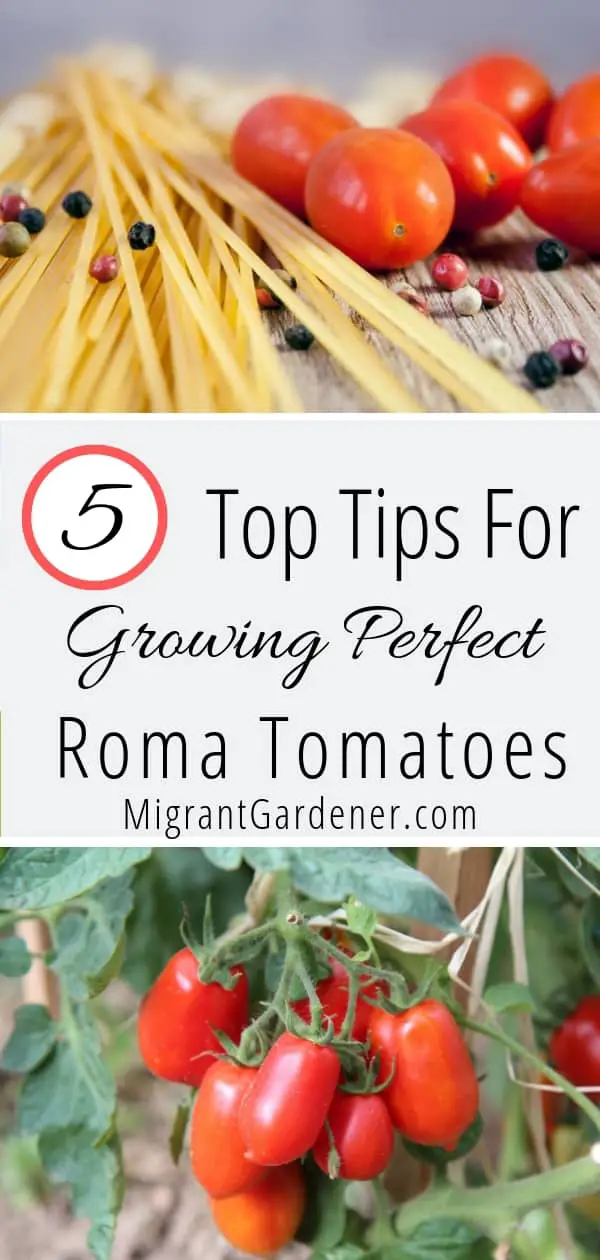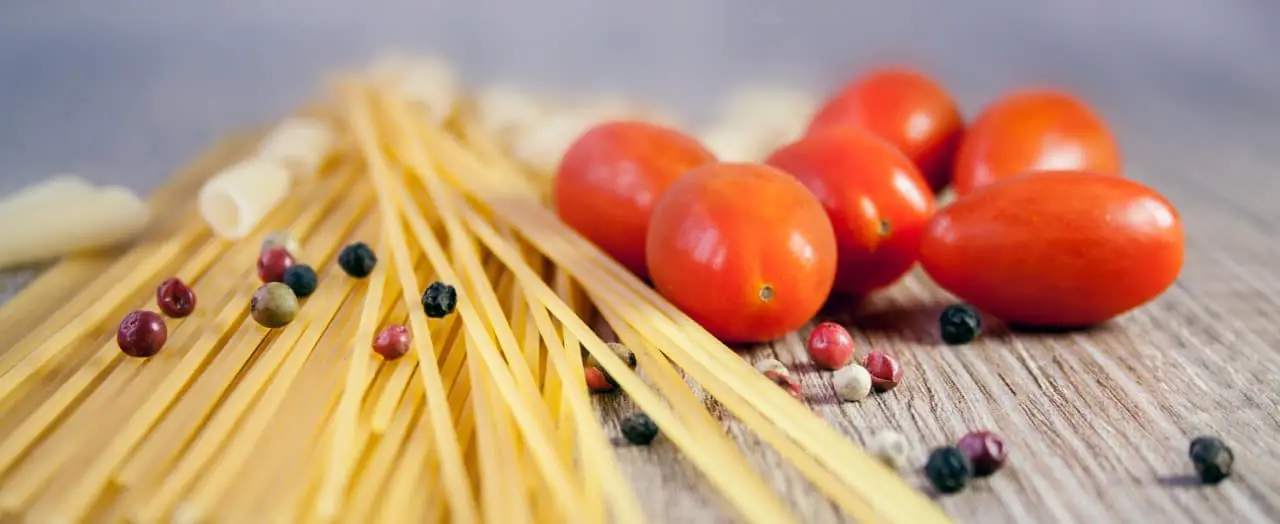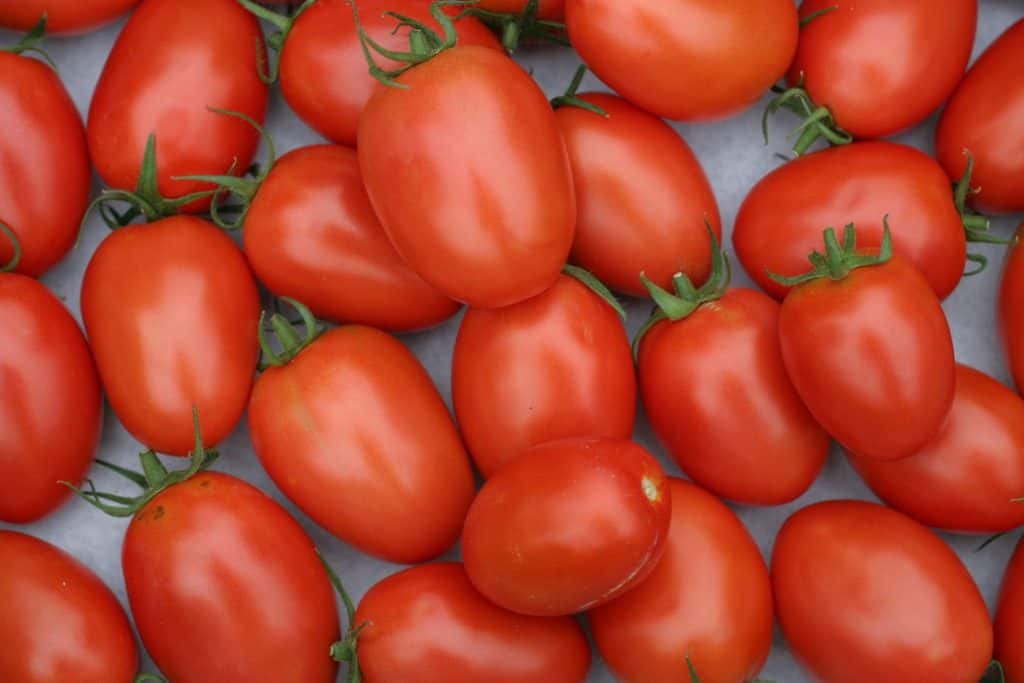How to Grow Roma Tomatoes
How to grow Roma tomatoes – Enjoy a good tomato sauce that’s freshly made at home?
Then you should be growing Roma cherry tomatoes!
Read: Best tomato for sauces.
The wonderful Roma tomato is also an excellent choice for salsa.
Read: Best tomato for salsa.
But Roma tomatoes are not just an excellent choice for sauces and salsas. They’re a great all-rounder, really.
Read on for more details about what makes this large cherry tomato such an outstanding tomato.
Roma Tomatoes: Some quick facts…
Plant height: 4 to 6 feet, depending on variety.
Sun: Ideally, full sunlight for at least six hours daily.
Fruit size: 3 inches in length.
How far apart to grow Roma tomatoes? How much room do Roma tomatoes need to grow?
Plant Roma tomatoes 24 to 36 inches apart in rows, depending on variety. Spacing between rows, if there’s a need to add more than a single row and you’re looking at 4 feet between rows. Roma tomatoes are Determinate plants so they don’t require quite as much space to develop as indeterminate tomato varieties.
How long does it take to grow Roma tomatoes?
73 to 80 days after transplanting before the fruits are harvestable. The length of time the actual plant grows is dependent on climatic conditions.
How to grow big Roma tomatoes?
Roma tomatoes grow to around 3 inches in length. Average weight of a Roma tomato is about 2oz/ 60g. Can you grow them any larger than this?
Sadly, no. There are ways to ensure a prolific harvest. Basically that comes down to providing your tomato plants with optimal growing conditions. But to actually, and with intent, grow larger-sized Roma tomatoes is not possible to achieve.
Can you grow Roma tomatoes outdoors?
Yes, for sure. You can grow Romas outdoors in your garden or outdoors in pots. The choice is entirely yours to make.
How to grow the best Roma tomatoes?
Well, one way of helping to ensure you get the best Roma tomato crop is to follow the outline in this guide – in this article. I’ve included numerous tried and trusted methods in this guide for growing excellent Roma tomatoes.
(Incidentally, this post contains links to products. Please make the assumption that at least some of the links may result in earning commissions. Thank you.)

So, What is a Roma Cherry Tomato?
Rather than being shaped like a cherry, Roma tomatoes are plum-shaped.
They are regarded as ‘paste tomatoes,’ and they have a tendency to be relatively heavy, given their small size.
Roma tomatoes are also firmer than their non-paste tomato counterparts.
The plants are determinate in habit, and the fruits all ripen around the same time, as opposed to having a season-long ripening pattern.
Read: What is the difference between determinate and indeterminate tomatoes?
Though you can, for sure, eat your Roma cherry tomatoes straight off the bush, they are better used as a sauce or for making a paste once they’ve been cooked.

Let’s now find out about…
the best way to grow Roma tomatoes – how to grow Roma tomato plants for best results.
When to Plant Roma Tomatoes? When to Grow Roma Tomatoes?
When to plant Roma tomato seeds?
Start your Roma tomato seeds off around two months prior to the predicted last springtime frost date in your area.
In general, tomato seeds take approximately eight weeks before they germinate.
If you do wish to grow from seed (as opposed to purchasing tomato transplants from a garden center or farmers’ market, plant the seeds in containers and provide them with the necessary conditions (frost-free is an obvious prerequisite among other things) so they can develop into healthy seedlings.
How to Plant Roma Tomato Seeds
For sowing seeds, you’ll want to get a potting mix which is available at any garden center. You can, if you have a preference, go for the more costly ‘seed mix’. Entirely a personal matter. The benefit of seed mixes is that they tend to – or are supposed to – better aid with root development than general potting mixes.
A good quality seed potting mix for tomatoes is Hoffman Seed Starter Soil:
Miracle-Gro also does an excellent range of seed-starter potting mixes.
You may wish to use cell packs for your seeds. For many folks, they prefer individual pots for seeds. Individual pots allow the seeds to develop to a decent size with no constriction upon the roots.
Huvai 4-inch Plastic Pots for Tomato Seeds (100pcs)
Moving on.
Fill your pots so that the mix is approx half an inch from the top.
I like to pair the seeds up and position them in the center of the pot. If one of them fails to sprout then chances are at the very least reasonable that the other one will come away successfully.
If they do both sprout, then you’ll want to pinch out the weaker of the two. More about that shortly.
Cover your tomato seeds with a layer of potting mix – quarter-inch deep should do it.
Compress using your fingers. You’ll want a solid contact between the seeds and the soil, hence the reason for compressing.
If the top of the potting mix appears to be dry, sprinkle some water over the top. Never allow the potting mix to remain soggy wet. Doing that will likely cause rot.
You’ll want to position your tomato seeds in a sunny window (unless of course you have a greenhouse then you’re good to go!)
You’ll want your tomato seeds to receive a minimum of four hours of direct sunlight daily. Ideally, a bit more than that.
And with warmer temperatures comes faster seed germination. Keep the temperature above 60ºF.
If you’re unable to achieve that – or you don’t want to handle the cost of it – you can invest in a heat lamp or in seedling heat mats.
Vivosun Seedling Heat Mat (waterproof)
There is a simpler (and cheaper) approach to keeping the ambient air temperatures up where your tomato seeds want them to be.
Utilize the greenhouse effect of covering your pots with opaque, clear plastic (clingfilm would work). This way, when the sun is shining the heat is captured. And at night, the plastic retains the heat.
Do be sure, if you opt for this latter method of covering with plastic, that you remove the plastic as soon as your tomato seedlings begin to germinate.
If you don’t, the seedlings can easily die off because of what is known as damping-off disease. This is a fungal infection that multiplies in moist, still air.
For all kinds of seedlings, and certainly for tomato seedlings, damping-off disease can be a real threat. To combat it you should provide plenty of air circulation throughout the period of time that the tomatoes are still at seedling stage.
An open window (at least from time to time) is helpful – providing that the exterior air temperature is at room temperature or higher. A very small fan is another option.
How to Plant Roma Tomatoes
If you’ve grown any other type of tomato – Campari tomatoes, San Marzano tomatoes, you name it – you’ll know how to grow Roma.
The plants require plenty of water.
Roma needs an organic-rich soil for best results.
What’s more, it also requires staking to ensure ultimate fruit production.
How deep to plant Roma tomatoes?
We’ve covered aspects involved in sowing Roma tomato seeds up above. You sow the seeds a quarter- to a half-inch deep.
When transplanting to the garden or into larger-sized containers, plant them deeper than when they were in small-sized pots as seeds and seedlings. How deep is ‘deeper’?
Tomato growers will give you a different answer to this, depending on who you talk to. But a solid way to progress is to plant to just below the level of the lowest pair of leaves. Roots will then form right up the part of the stem that’s in the soil. A larger root system, in general, makes a healthier plant.
It’s worth pointing out at this stage that as a way of reducing the risk of root disease occurring, avoid planting your Roma tomatoes (or any other tomatoes) in soils that have recently been used to grow tomatoes, peppers, eggplants, or potatoes.
Wait until at least a couple of years have passed before using the same area of your garden for tomatoes.
Best Soil Conditions for Roma Tomatoes
Sandy or loam soils work best for all varieties of tomatoes, including Roma.
In fact, tomatoes will grow in pretty much any soil type, though they don’t do well in clay soils.
If your soil is more clay than anything else, it’s easy enough to alter the texture through regular cultivation.
Add in sand and organic materials on a regular basis to lighten a clay soil.
Organic materials can include leaf compost, sawdust, or any other form of organic compost.
Ideally, for tomatoes, the soil should be quite loose and it should also be well-drained.
Best Soil pH for Roma Tomatoes
For Roma tomatoes, or for any type of tomato, the pH of your soil should be on the acidic side of the neutral mark – anything around 6.3 to 6.8 is good.
If you need to modify the pH of your soil, you can raise it from being overly acidic by adding in ground agricultural lime.
On the other hand, to lower the pH from alkaline soil, add elemental sulfur.
Either that or you can lower the pH through the addition of ammonium sulfate which can be found in many fertilizers.
Roma Cherry Tomato Fertilizer
The fertilizer you use should be higher in phosphorus and potassium than in nitrogen.
Jobe’s Home Grown Tomato, Vegetable, and Herb Fertilizer with an N-P-K ratio of 4-6-3 is an excellent choice for tomatoes.
JR Peters 51324 Jack’s Classic 12-15-30 Tomato Feed is also an excellent choice.
Both of these fertilizers are suited to the needs of the majority of vegetables, too.
Watering and Staking Roma Tomatoes
You should water your Roma tomatoes at least once per week, if not more, depending on the prevailing weather conditions.
Once your plants reach a height of between 6 and 12 inches, it’s time to stake them to provide them with support.
You can, instead of stakes, use cages, though I’ve almost always used simple stakes like these ones:
Hydrofarm HGBB4 4′ Natural, Pack of 25 Bamboo Stake, 4 Foot, Tan
Keep in mind that the ultimate height of your Roma tomato plants will depend on the variety.
For most red Romas, they reach a growing height of around 48 inches – 4 feet tall.
On the other hand, for San Marzano, you can expect a growing height of around 6 feet.

Do Roma Tomatoes Have Disease Problems?
Fortunately, Roma tomatoes have a strong capacity for remaining disease-free throughout the season.
Verticillium and fusarium wilt diseases are commonplace among tomatoes.
Roma rarely succumbs to either, however.
When Do Roma Tomatoes Ripen?
Due to the fact that Roma cherry tomatoes are firmer than other tomato varieties – have a firmer flesh – how do you know when they are ripe and ready to be harvested?
The color of the fruit acts as the best indicator.
After the fruits are red throughout – from the base to the tip – you’ll know that they are ready to pick.
And answers to a few other Roma tomato related questions:
How to grow Roma plum tomatoes?
This article is about growing Roma plum tomatoes. Follow the procedures outlined above and you’ll more than likely enjoy a healthy crop and a bountiful harvest.
How to grow Roma tomatoes in Florida?
Same procedures apply to growing Roma tomatoes elsewhere as you would in Florida. Follow the procedures outlined above and chances are your results will be more than satisfactory whether growing in Florida or elsewhere.
When to plant Roma tomatoes in Texas?
If your question is when to plant Roma tomatoes as seedlings (not as seeds) then the answer is you should plant after any danger of frost has well and truly subsided.
Taking Dallas as an example, the typical final frost day in spring lands on or about March 12.
Give it a couple of weeks after this date to be pretty certain (as certain as you can be, sort of thing) that there’s not going to be any further frost. That’s the time to plant your seedlings outdoors in Texas.






I truly love developing cherry tomatoes on my lawn! An obligation of
appreciation is all together for sharing a great deal of Information.
Hi Kristine, thanks for your comment and I hope your cherry tomatoes taste terrific!
Joseph